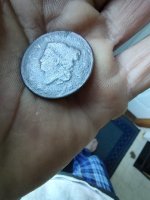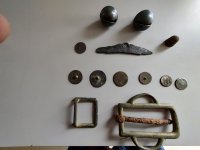KGCnewbieseeker
Sr. Member
An aura of mystery and timelessness surrounds the San Juan Mountains. Indeed, some sections of the Old Spanish Trail through the San Juan wilderness are still marked by trees blazed by early Spanish explorers and travelers. Old Spanish prospect pits, arrastres, and tunnels can be found throughout the San Juans. The La Plata Mountains have yielded abundant evidence of early Spanish mining activities including the skeleton of a man clad in Spanish armor and the remains of primitive arrastres and sluice boxes. The Escalante-Dominguez expedition found evidence of earlier mining activities in the La Platas when they passed through the area in 1776. Anglo-American prospectors in the Silverton area also encountered abundant signs of early Spanish activity. Arrastre Gulch, near Silverton, contains old Spanish arrastres actually cut into the bedrock. An old mine found in Poughkeepsie Gulch, north of Silverton, contained primitive copper tools of Spanish make. Tree-ring dating of timbers left in an old Spanish mine on Elk Creek, near Silverton, yielded a cutting date of 1712.
Tales of lost mines and caches in the San Juan Mountains are rife, but many are historically based. Indeed, the existence of many lost mines in the San Juans is supported by official documentation (including assay records in Durango, Silverton, and Ouray). Prospectors of the San Juan Mountains should always remember that the Tomboy/Camp Bird region, northeast of Telluride, was scoured for 20 years before the fabulous Camp Bird lode was discovered in 1895. One of the top 3 gold mines in the state of Colorado was found in an area that had been thoroughly prospected for 20 years!
Some 25 years before the Escalante-Dominguez expedition of 1776, a group of Spaniards and Frenchmen discovered an extremely rich gold mine somewhere near the headwaters of Ute Creek. This group of prospectors included Toribio Hernandez, Felecito Garcia, and Rene de L'Archeveque. (Rene de L'Archeveque was the son of Jean de L'Archeveque, one of the murderers of LaSalle
in 1687; Jean de L'Archeveque was a member of the ill-fated Villasur expedition which was massacred by Pawnee Indians near the Platte River on August 15, 1720.)
The mine was located near the Continental Divide within sight of those two famous landmarks: La Ventana (the "Window") and El Serro de la Piramide (the Rio Grande Pyramid). According to Felecito Garcia, the "Window" could be seen from the portal of the mine!
The miners quickly established a routine of working the mine and transporting the ore to local caches. (One of the largest caches was "2 sleeps away" in the Piedra River watershed, somewhere in the mountains surrounding O'Niel Park. This cache has never been found.) After each season, the miners carefully concealed the portal of the mine with timber and rocks. The Ventana Mine was worked for several years until the early 1770's when the miners' luck ran out. Ute Indians attacked the Spaniards while they were working the mine, killing several. The panic-stricken survivors fled from the mine but were ambushed again by the Utes. This time Toribio Hernandez and Rene de L'Archeveque were killed. Felecito Garcia was one of the few survivors to emerge from the wilderness. Before he died, Garcia revealed the location of the mine to his son. Garcia told him that the mine was west of La Ventana, somewhere on the Ute Creek drainage, and that the "Window" could actually be seen from the portal of the mine. The legend of the Lost Ventana Mine was born. (In 1919, an alleged descendent of Felecito Garcia entered the San Juans in search of the lost mine. Jose Garcia combed the slopes of Ute Ridge but found nothing.)
The existence of the Ventana Mine is supported by occasional discoveries of rich "float" along Ute Creek. (One specimen of float assayed out at $58,000 per ton!) A mineralized zone does exist near Indian Ridge, roughly 2 miles northwest of Ute Ridge. It is conceivable that one or more rich veins also crop out along the Continental Divide near the headwaters of Ute Creek. Finally, in 1936, a treasure hunter discovered a cache of rich gold ore on West Ute Creek. (This cache was found near timberline.) The following year, another cache of gold ore was discovered on Middle Ute Creek.
Tales of lost mines and caches in the San Juan Mountains are rife, but many are historically based. Indeed, the existence of many lost mines in the San Juans is supported by official documentation (including assay records in Durango, Silverton, and Ouray). Prospectors of the San Juan Mountains should always remember that the Tomboy/Camp Bird region, northeast of Telluride, was scoured for 20 years before the fabulous Camp Bird lode was discovered in 1895. One of the top 3 gold mines in the state of Colorado was found in an area that had been thoroughly prospected for 20 years!
Some 25 years before the Escalante-Dominguez expedition of 1776, a group of Spaniards and Frenchmen discovered an extremely rich gold mine somewhere near the headwaters of Ute Creek. This group of prospectors included Toribio Hernandez, Felecito Garcia, and Rene de L'Archeveque. (Rene de L'Archeveque was the son of Jean de L'Archeveque, one of the murderers of LaSalle
in 1687; Jean de L'Archeveque was a member of the ill-fated Villasur expedition which was massacred by Pawnee Indians near the Platte River on August 15, 1720.)
The mine was located near the Continental Divide within sight of those two famous landmarks: La Ventana (the "Window") and El Serro de la Piramide (the Rio Grande Pyramid). According to Felecito Garcia, the "Window" could be seen from the portal of the mine!
The miners quickly established a routine of working the mine and transporting the ore to local caches. (One of the largest caches was "2 sleeps away" in the Piedra River watershed, somewhere in the mountains surrounding O'Niel Park. This cache has never been found.) After each season, the miners carefully concealed the portal of the mine with timber and rocks. The Ventana Mine was worked for several years until the early 1770's when the miners' luck ran out. Ute Indians attacked the Spaniards while they were working the mine, killing several. The panic-stricken survivors fled from the mine but were ambushed again by the Utes. This time Toribio Hernandez and Rene de L'Archeveque were killed. Felecito Garcia was one of the few survivors to emerge from the wilderness. Before he died, Garcia revealed the location of the mine to his son. Garcia told him that the mine was west of La Ventana, somewhere on the Ute Creek drainage, and that the "Window" could actually be seen from the portal of the mine. The legend of the Lost Ventana Mine was born. (In 1919, an alleged descendent of Felecito Garcia entered the San Juans in search of the lost mine. Jose Garcia combed the slopes of Ute Ridge but found nothing.)
The existence of the Ventana Mine is supported by occasional discoveries of rich "float" along Ute Creek. (One specimen of float assayed out at $58,000 per ton!) A mineralized zone does exist near Indian Ridge, roughly 2 miles northwest of Ute Ridge. It is conceivable that one or more rich veins also crop out along the Continental Divide near the headwaters of Ute Creek. Finally, in 1936, a treasure hunter discovered a cache of rich gold ore on West Ute Creek. (This cache was found near timberline.) The following year, another cache of gold ore was discovered on Middle Ute Creek.





